
Northern Pike Spawn Delayed
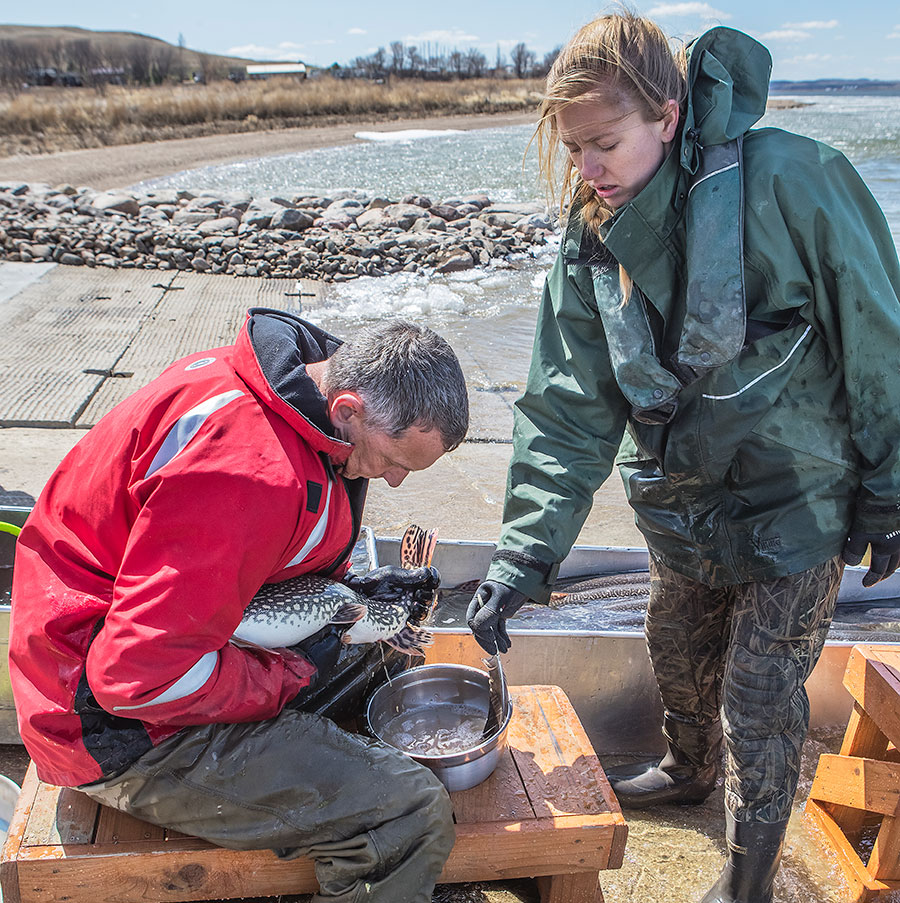
Brandon Kratz (left), Department southeast fisheries supervisor, squeezes the eggs out of a female northern pike while Kelly Zorn, Department seasonal employee, stirs the bowl of milt and eggs with a goose feather.
When North Dakota Game and Fish Department fisheries biologists set trap nets in Lake Oahe in spring for the northern pike spawn, they were as late to the game as they’d been in years.
With such a delayed ice-out on Oahe and other waters around the state, the only certainty regarding the spawning of North Dakota’s state fish were the uncertainties.
“This is one of the latest springs we’ve ever encountered as Mother Nature threw a monkey wrench into our plans,” said Paul Bailey, south central district fisheries supervisor in Bismarck. “Typically, we’re collecting northern pike eggs around the second week of April. We’re about two weeks behind right now, which has only happened once before (1989 at Devils Lake).”
Fisheries biologists set nets on April 23, the latest in the last 30 years. The first pike eggs and milt were stripped into a stainless steel bowl and gently stirred with a goose feather three days later, also the latest since 1997.
While photoperiod, or day length, and water temperatures are the combined ingredients pike need to spur reproduction, there was some question when Oahe’s shallower back bays would warm enough to initiate reproduction.

Jerry Tishmack, Garrison Dam National Fish Hatchery fisheries biologist, empties a jar of fertilized pike eggs into a cooler for transport to the hatchery.
“It’s definitely going to be a very short, intense spawning period this year,” Bailey said. “Usually, things are spread out over a several week period where we have lots of opportunities to collect eggs.
“Things are happening very fast right now as it has warmed up quite quickly,” he added. “Two days ago (April 24) Cattail Bay was covered in ice. Today (April 26), it is wide open and water temperatures are up into the low 40s, which is triggering these fish to spawn.”
To be prepared for the inevitable – be it the first or second week in April or much later – the trap nets used during the spawning operation were repaired in winter.
“There is nothing worse than getting to a lake with potential to find out that a muskrat has chewed a hole in a net,” said Scott Gangl, Department fisheries management section leader. “When the spawn is on, our staff don’t like to waste time.”
Turns out, when the pike decided they were ready, there was hardly a surplus of time.
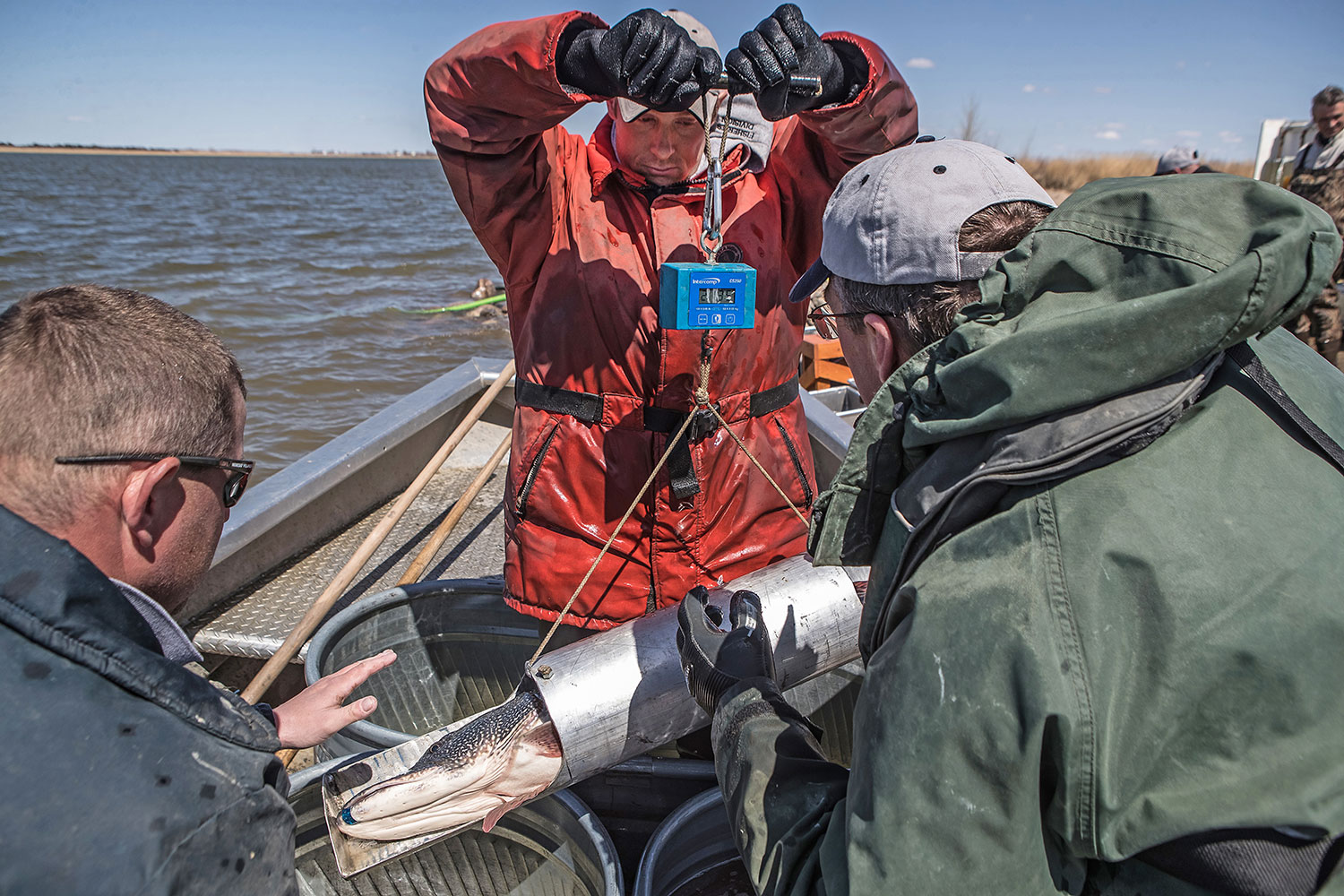
Fisheries biologists weigh a northern pike before releasing it back into Lake Oahe.
Game and Fish Department fisheries personnel went into spring with a goal of 150 quarts of pike eggs. Between spawning efforts on Oahe and Lake Sakakawea, more than 220 quarts were collected in just two days.
“Certainly, because it’s nearly the end of April, some of the fish spawned before we had the opportunity to collect their eggs,” Bailey said. “But a pretty high proportion of these pike did delay spawning as they waited for the appropriate water temperatures.”
Even though the pike spawn was weeks later this spring than typical, it likely won’t influence operations at the federal fish hatchery where room will soon be needed for walleye eggs.
Jerry Tishmack, fisheries biologist with Garrison Dam National Fish Hatchery, said the plan was to gradually increase the water temperature in which the pike eggs will incubate to make up for the late spawning date.
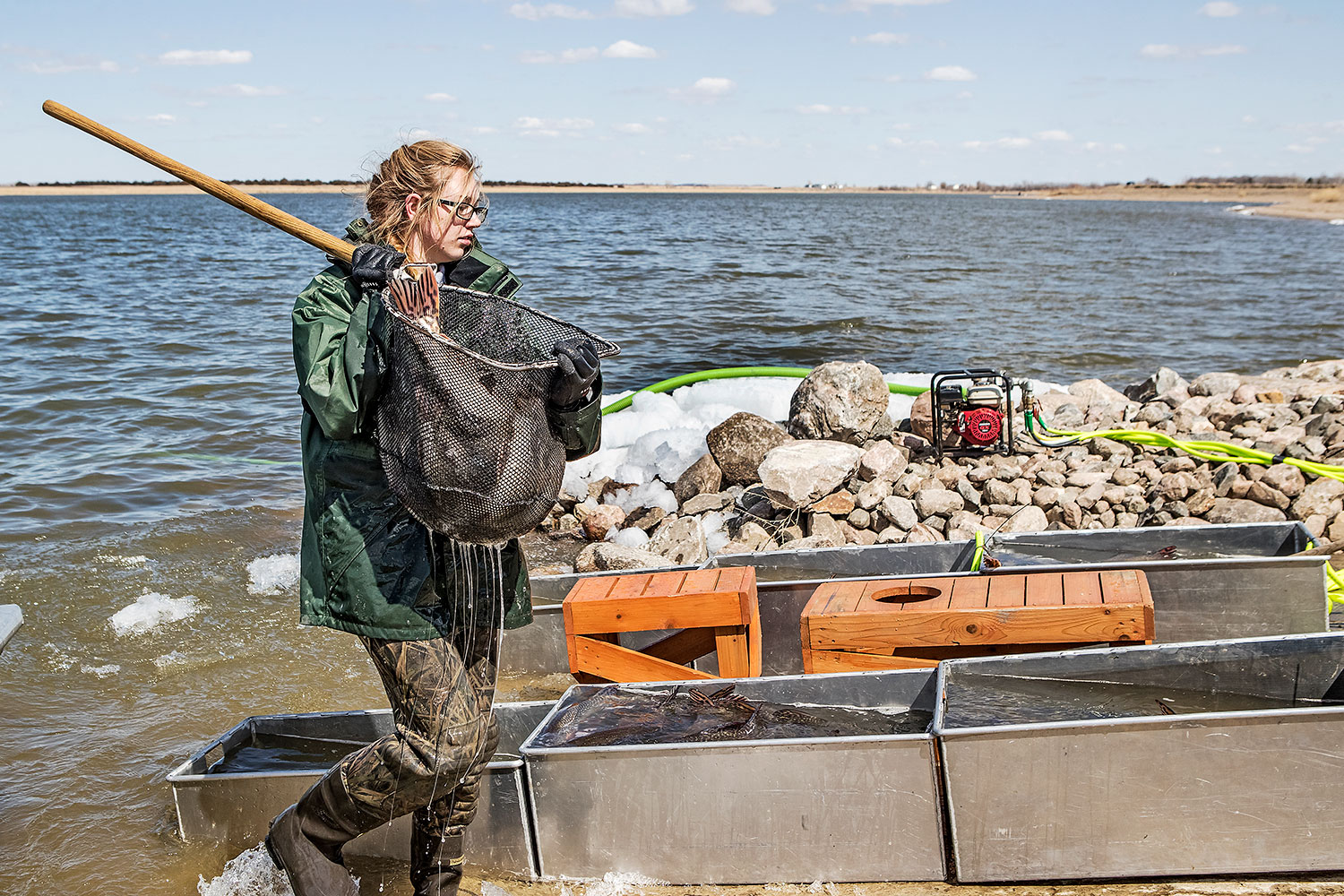
Kelly Zorn, Department seasonal employee, carries a net full of pike to the holding tanks in preparation for spawning.
“Typically, I will incubate northern pike eggs at 50 degrees, which means they will hatch in 10-12 days,” Tishmack said. “This year I will bump it up to 60 degrees and incubate them in nearly seven days. That will buy me nearly four or five days, which will close the window a bit.”
After hatching, the pike are raised in hatchery ponds until they are about 1.5 inches long. From there, Game and Fish Department personnel transport the pike to lakes around the state.
Taking the eggs from mature pike, and walleye after that, is simply the first step in nourishing the many lakes across North Dakota’s landscape that are enjoyed by thousands of anglers.
“This is an extremely important process as a number of our pike and walleye fisheries across the state lack the ability to sustain themselves through natural reproduction,” Bailey said. “These waters either do not have suitable spawning habitat, or in many cases, the salinity levels are too high for eggs to successfully hatch. Our pike and walleye spawning operations, and our partnership with Garrison Dam and Valley City national fish hatcheries, are essential for maintaining a number of important fisheries around the state.”
Trophy Study
North Dakota Game and Fish Department fisheries biologists tagged dozens of big northern pike in 2017 as part of an ongoing study to determine how anglers utilize trophy fish.
While some of those jaw-tagged pike were caught by anglers in winter and the tag numbers reported to Game and Fish, biologists understand that the findings so far are preliminary, considering the small sample size.
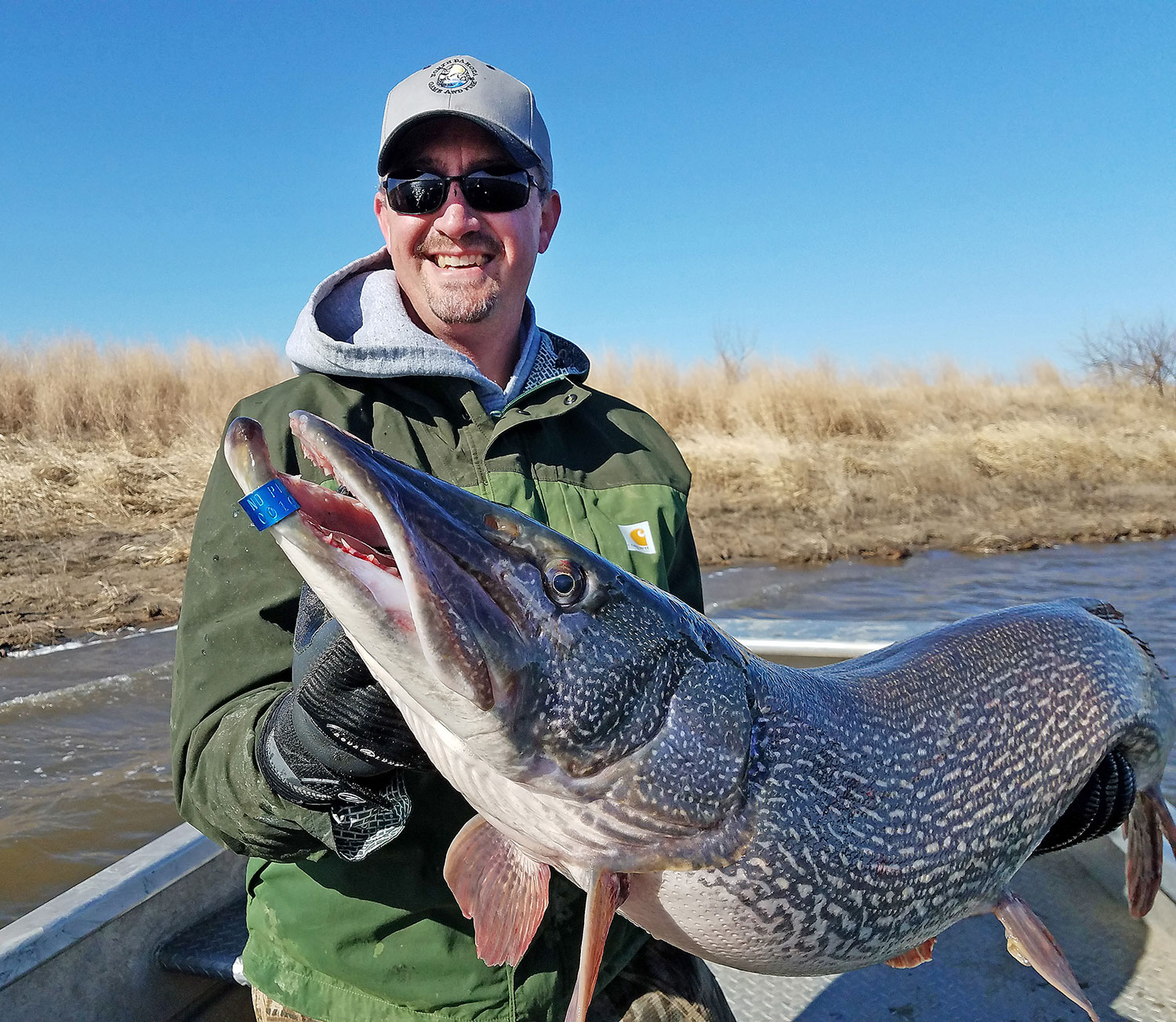
Scott Gangl, Department fisheries management section leader, holds a trophy northern pike. The fish was fitted with a jaw tag as part of study of Lake Oahe’s trophy pike fishery.
Yet, understanding the interest by anglers today in trophy management of big northern pike, the small sample size signals a start.
The Missouri River System study was initiated last spring during Department pike and walleye spawning efforts on lakes Oahe and Sakakawea. Tags were secured to pike measuring 39.4 inches (1 meter) or longer.
In total, 75 qualifying pike from Lake Oahe and 62 from Lake Sakakawea received tags in spring 2017. Paul Bailey, south central district fisheries supervisor in Bismarck, said biologists hope to tag more fish this spring during spawning to increase the sample size of a study that could run the following three to five years.
Of the 75 trophy pike tagged in Oahe, Bailey said 19 were caught by anglers. Fifteen were released and four were harvested.
“The number of fish netted and tagged (from Oahe) by biologists is, understandably at this point, a small sample size,” Bailey said. “Yet, I’d say it’s interesting that anglers did encounter 25 percent of that sample size.”
And they harvested just 5 percent, Bailey said.
“Preliminary findings say that anglers are not harvesting an excessive number of the trophy fish,” he said. “It doesn’t look like anglers are having an impact on trophy pike in Oahe.”
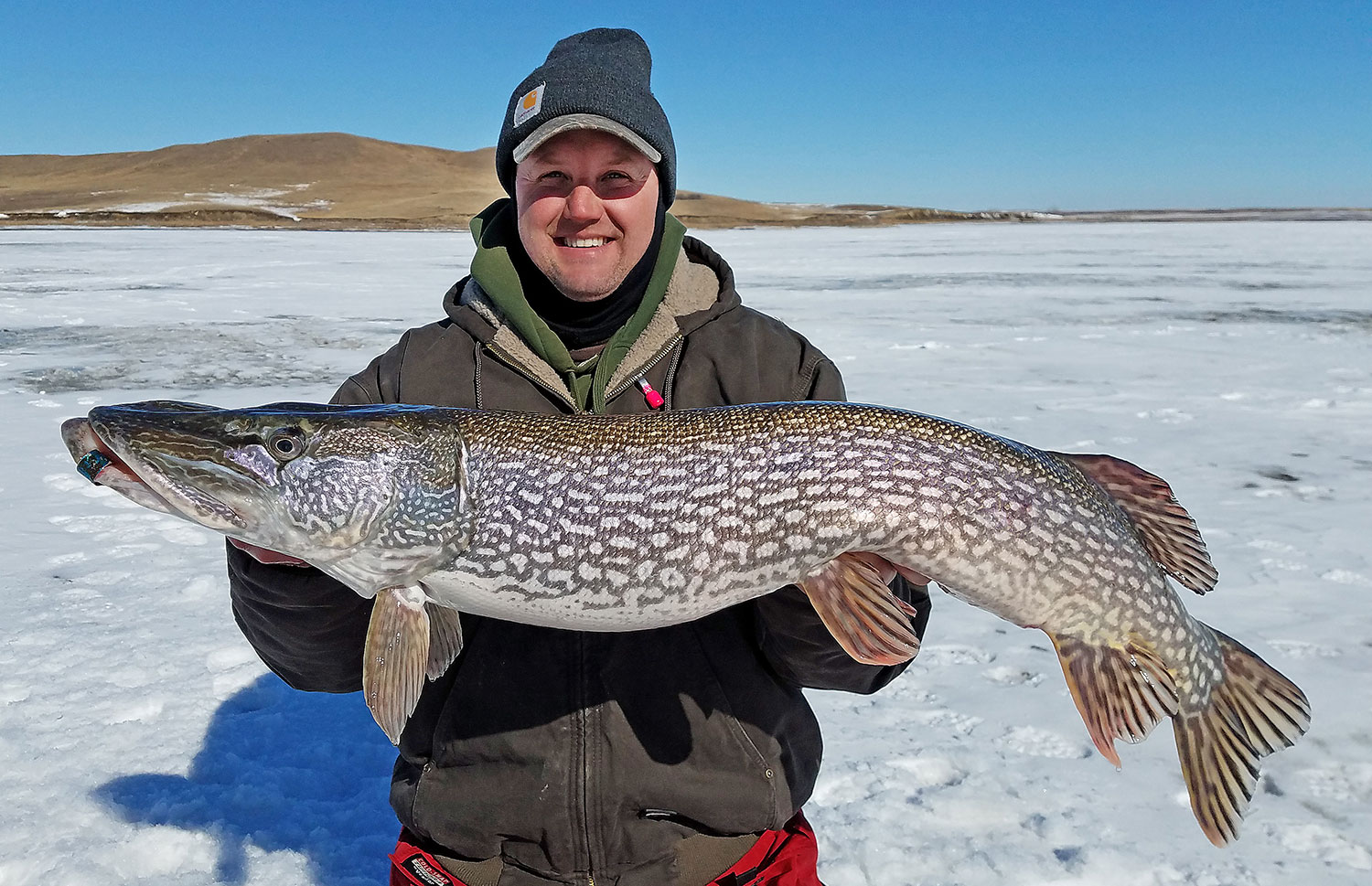
Justen Barstad, Department fisheries technician, holds a trophy pike he caught while ice fishing March 1, 2018 on Lake Oahe. The fish is one that Barstad tagged during spawning work on April 8, 2017.
Of the 62 tagged pike on Sakakawea, anglers caught and released four and harvested four, according to Dave Fryda, Missouri River System fisheries supervisor in Riverdale. Fryda said one jaw-tagged pike was also taken by someone darkhouse spearfishing.
Bailey said it takes a pike in Oahe about a decade to reach trophy size, or the 39.4-inch bar set by Game and Fish for the study.
The biggest pike fisheries biologists tagged from Oahe in 2017 was 47.6 inches. It weighed 29 pounds, 7 ounces.
“Oahe is definitely a world class trophy pike fishery now and, at least preliminarily, it looks like our current regulations and angler harvest rates will continue to allow Oahe to produce a trophy pike fishery into the future,” Bailey said.
Interestingly, on March 1, 2018, Justen Barstad, Department fisheries technician in Bismarck, caught a trophy pike while ice fishing on Oahe that he had tagged during spawning work on April 8, 2017.
The 42.1-inch pike was about 1 pound lighter from when it was tagged to when it was pulled through the ice.
“This fish should put on a bit more weight prior to spawning, but it does confirm how variable weights of these large pike can be over time,” Bailey said.
